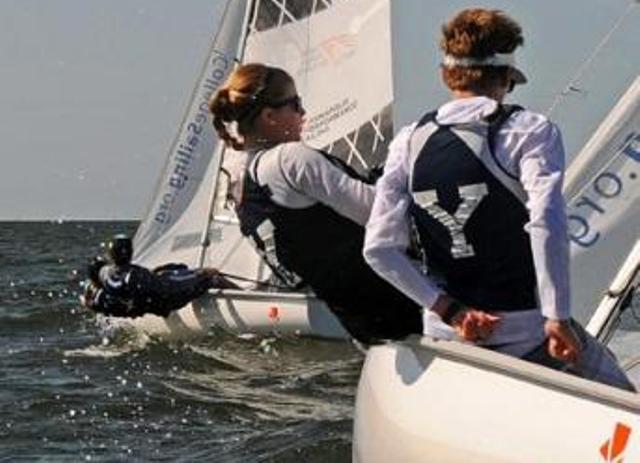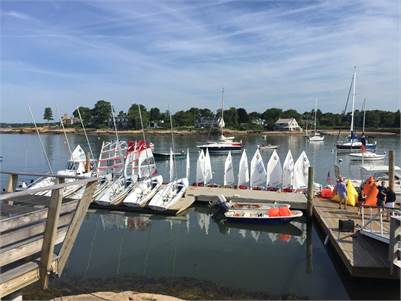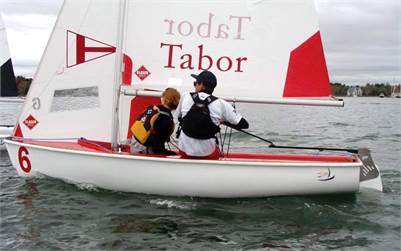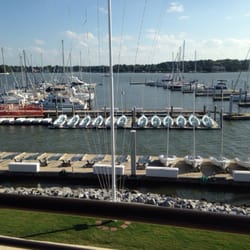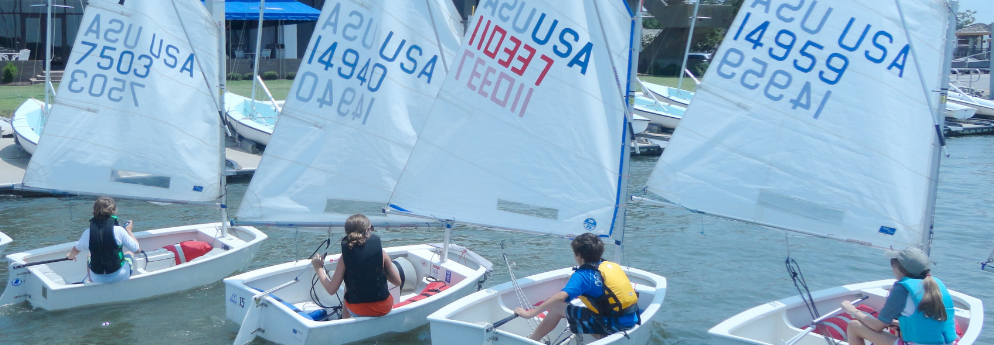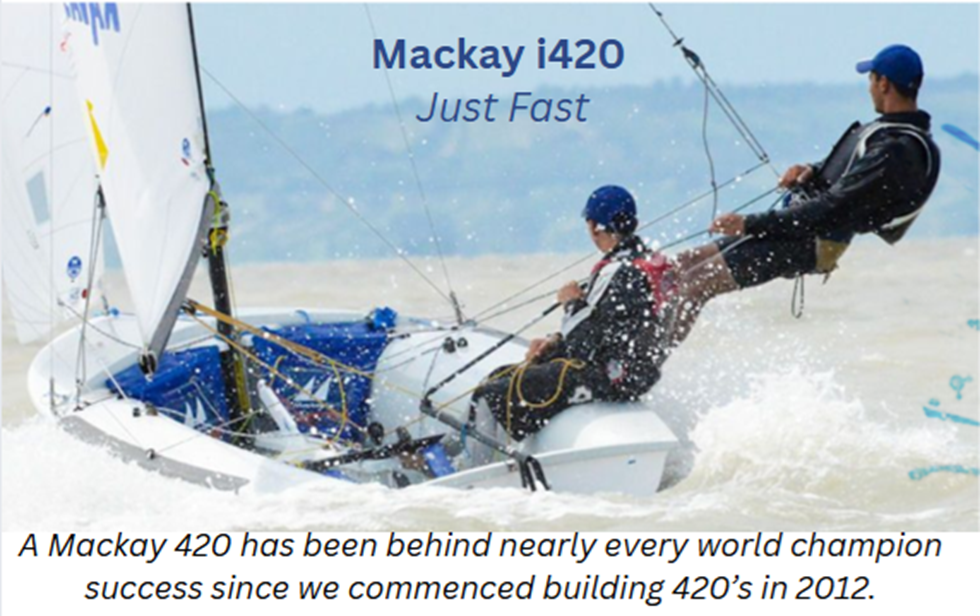
Along with job postings, we also developed a resume posting service; this allows interested candidates to post their credentials securely and privately. This service is free (featured resume posts require payment), and it has grown tremendously over the years. If you are considering a new opportunity, or want to see what’s out there.
Likewise, employers can search our resume database to find the right match for that open position. Employers, there are hundreds of active resumes on file, with new ones added quite often. If you are eagerly searching for new candidates, don’t wait; this is a great way to meet new potential applicants!!
Sail1Design is proud also to be the official job board of the Intercollegiate Sailing Association (ICSA), the US High School Sailing Association (ISSA), and US Sailing.
Club Profile: Lake Sunapee Yacht Club
News Flash: Lake Sunapee Yacht Club is Hiring a Sailing Program Director!

LSYC is the host of a large inland fleet of Star class one design racing boats and offers an active weekend racing schedule that non members are encouraged to join. Click the Star Racing menu for 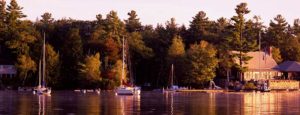
The LSYC is a private club, however Star sailing and regattas are open to non-members.
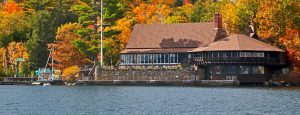
News Flash: Lake Sunapee Yacht Club is Hiring a Sailing Program Director!
Who’s Your Crew? College Team Race Season Preview & Who's Who, Part I
By Chris Klevan

Team Racing requires a combination of knowledge, skills, and teamwork. To compete at the highest level, a team of three boats, sailing in concert, must have the experience to execute split second maneuvers, and have chemistry to communicate and adapt to dynamic changes in the play, and finally, the speed to sail away.
The biggest factor that separates the players from the pretenders is the third skipper. All the top teams have two boats with blinding speed, great boat-handling, and an eye for beating another boat. But only the top teams have three skippers with such a combination. That’s the first thing to look for when trying to discern who’s ready for the big league. However, the factor that separates the players from the champions is the crew. Who’s in the front of the boat will dictate who comes away with the crown.
However, for a championship caliber team to become a dynasty, a team that can win the championship year after year, it takes 6 full boats that can team race at the highest level. “Yale’s ability to bring in the recent grads, GTown’s depth overall [these are the difference-makers.] If you don’t have solid people to practice against, it’s hard to improve because your mistakes are not accounted for in practice,” says Cornell University head coach Brian Clancy. Quality practice breeds the players of tomorrow. To fully forecast the future of college sailing, you must dive into who’s been practicing with depth.

The 2018 ICSA Team Race National Championship will be held at Old Dominion University, May 26-28
College of Charleston
Last year, we saw the College of Charleston Cougars take home the Team Race Championship behind the prowess of Stefano Peschiera, Jack Cusick, Christophe Killian, Grace McCarthy, Chloe Dapp, Annabel Carrington, Caroline Bracken and Elizabeth Pemberton. With any title defense the first place to start is with the question, what has changed?

First, Charleston will have to prove they can win away from home. It will be interesting to see how the Cougars come out of the gate this spring season. Last season, the first interconference team race regatta that Charleston won was the National Championship regatta. Perhaps they found an advantage on their home waters. Perhaps their breakthrough came at the right moment. There are more questions remaining here than with most defending champions. They certainly have the continuity required to maintain the momentum gained in taking home the Wood Trophy.
Last year’s championship team featured only two seniors, Jack Cusick and Chloe Dapp, who, now removed, the Cougars will be looking to replace. Many look to transfers Augie Dale ‘19 and Katherine Lounsbury ‘20 to pick up the slack. Dale and Lounsbury are the natural choice to step in for the Cougars after an impressive fall fleet race season. The tandem notably won A-Division at the Atlantic Coast Championships. They say speed makes you look smart. Dale has yet to prove himself on the team race circuit, but, at the very least, he’s proven that he has the wheels to compete. Though we’ll have to wait to see how Dale and Lounsbury fit, Charleston’s other two boats are extremely solid.
Christophe Killian, a match-race specialist, finished 2nd at this year’s Match Race National Championship and was part of the ICSA Match Race Championship boat in 2015, driving, as just a sophomore. There are many parallels between the two disciplines and Killian proved that last year in Charleston’s championship effort. Therefore, on the team race course, Killian was not the “third” last year, and he will not have to step up for Charleston to return to championship form. Replacing Cusic is a much more natural task for the speedster, Dale.
Stefano Peschiera is in the driver’s seat for this year’s College Sailor of the Year award and he was a dark horse candidate last year. He is arguably the best sailor in the country right now with slippery speed and dominant boat handling. The question lingering as we entered the championship season last year was if this great sailor could figure out the college team racing game. Such doubt was quickly silenced during last year’s event. No such questions are being asked this year.
Finally, it cannot be understated that Charleston’s victory last year featured a stable of experienced and versatile crews- quality that is especially characteristic of all the great Charleston teams. Good crewing is a necessity for a team to compete at the highest level of team racing. The Cougars only lost one of their starting crews from last year’s team. Expect the story behind Charleston’s success to remain the same in their title defense this year as they venture away from the shores of the Cooper River, north, to Old Dominion University.
Yale University
Charleston’s win at the 2017 championship came as a surprise to most. Those shocked, likely had Yale pinned as the favorite. Reaching dynastic status on the Team Race circuit, the Bulldogs of Yale had won four straight national championships before finishing second in last year’s championship. However, this year will be much more uncertain for Yale.
The path to the championship for Yale is extremely difficult. Yale must qualify as one of the 4 teams to represent the New England Conference at the New England Conference Championship. Before their 4-year run of championships, Yale was only featured sporadically despite fielding some of the best talent in the nation- a testament to the depth of the conference and the challenge presented by the qualification process. The question now is whether the Bulldogs will yet again be able to transcend above the competitive NEISA conference.
On one hand, like Charleston, they have 2 team race national championship winning helmsmen in Malcolm Lamphere (2 time champion) and Nicholas Baird, who is still in the running for this year’s college sailor of the year award. On the other hand, the third skipper hole they are attempting to fill is a big one.
Last year, Yale graduated Ian Barrows, the 2017 College Sailor of the Year and a finalist the year prior. He was a four time All-American, a three-time Team Race Champion, a three time Fleet Race National division winner, a two time Fleet Race National Champion and a team leader. Furthermore, his graduating class was stacked. Yale graduated 3 excellent crews, one being Clara Robertson, the 2017 recipient of Julia Babineau, NEISA crew of the year. Another being Natalya Doris, perhaps an even more experienced crew than Robertson.
They also graduated Mitchell Kiss, a consistent starter at the skipper position. Kiss was probably good enough to be the best sailor on all but a handful of teams in college sailing and the fact that they had 4 skippers good enough to compete at the pinnacle of college team racing meant their practices were unmatched. This, however, is the biggest argument for Yale’s continued successes this upcoming season. For years now, Yale has been practicing a level most coaches could only dream of, sailing 6 solid boats. Yes, they lost 2 and a half premier boats, but they are able to fill such large losses better than anyone.
Waiting in the wings are two skippers that have spent their team racing careers in the background, boosting the dynasty that appears, on paper, only to be 3 great boats. Junior Nicolas Hernandez is extremely speedy and will surprise competitors thinking that Baird and Lamphere are the only threats. Senior Casey Klingler is unquestionably the best female team racer in the nation- a crown she’ll take from last year’s college sailor of the year, Erika Reineke. On top of that, freshman Shaun Harvey proved last fall that he has the goods to compete at the highest level of college sailing. An embarrassment of riches, Yale’s weak boat will either be a very experienced speedster, the best female team racer in college sailing or one of the next bright stars in the sport.
The tough choice of third skipper is a good problem for Yale to have. This will boost Yale, again, to the position of favorite in NEISA. However, for them to get back atop the podium in 2018, their young crews, led by sophomore star, Graceann Nicolosi will have to step up in a big way.
Georgetown University
Finishing 3rd at last year’s championship, Georgetown was the one of the youngest teams at the event. An incredibly talented group, Georgetown returns all starters from last year’s effort with the exception of one crew, Albert Kraus. The experience gained by the young platoon last year cannot be overstated. That, coupled with an excellent rotation of crews, led by Meaghan MacRae and Haley Shea, will make Georgetown one of this year’s favorites with an extremely high ceiling to their potential.

Photo taken from the Georgetown University sailing facebook page
We should get our answer to this question relatively early in the spring season due to a change in how the Mid Atlantic Conference (MAISA) is approaching their team race season. The Graham Hall Team Race at Navy is a heavily weighted regatta. Callahan, and Georgetown, likely won’t have the luxury of experimenting with their roster this season. The Hoya team shown at the Graham Hall, early in the spring season, will likely be the team Callahan believes give them the best chance to win.
D’Elliscu lies somewhere in between Dorr’s experience and the talent of Segerblom and Logue, although to study abroad, he did not sail in the Fall of 2017. When placed in a similar position Segerblom and Logue are in now, Mr. D’Elliscu has yet to falter. Georgetown relied on D’Elliscu when conditions got light at the Fleet Race National Championship in San Diego, 2016. Just a freshman, Mr. D’Elliscu was clutch to close the championship campaign for the Hoyas. Despite the skills of 2016 sailor of the year, Nevin Snow, the Hoyas needed D’Elliscu and he delivered. Now, as a Junior, D’Elliscu will have to be one of the leaders for this Georgetown team to be a contender.
Hobart and William Smith Colleges
Many look for this team to take the step forward from great to elite. HWS finished 5th overall at the Team Race Nationals last year, but, like Georgetown, graduated only one player, Adam Schaefer, an alternate crew. However, unlike Georgetown, there is no question who they will start at the skipper position. The combination of Guzman, Hobbs and Miller with Weber, Flaherty and Kloc won’t have to look to establish chemistry or find speed. This season, for the northerners, will be about asserting their will on the league.
The reliability of Miller is the key for the stability of HWS. All other MAISA teams have question marks in the third spot of their depth chart. In order for Charleston to stay at the top, Augie Dale and Katherine Lounsbury will have to prove they have the chops, for Georgetown, their young guns will have to mature. HWS has three boats with the speed, smarts and chemistry together. On top of that they have the crews to finish the job.
According to head coach, Scott Ikle, it is the crews that will put this team over the top, led by Junior, Lindsey Kloc. “Like all great crews, Lindsey brings the best out of her skipper,” said Ikle. “Miller is solid skipper on his own, but last year, sailing with Lindsey, he was excellent.”
Boston College
Of teams finishing in the final four in last year’s championship event, Boston College looks to be most in jeopardy for a step backwards. Graduating 6 players from last years 4th place finishing team is tough enough. However, they also graduated 4 starters, 2 skippers- 1 being the women’s college sailor of the year. Erika Reineke left some big shoes to fill, but the loss of the elite All-American crews Hannah Lynn and Allison Ferraris may have left an even larger void.
Over the past decade, few schools have been able to match Boston College’s culture of reloading year after year. A team now proficient at producing a product greater than the sum of its individual parts, Boston College, throughout recent history, has been one of the premier sailing colleges in the nation. “Somehow I got lucky enough to have some very talented sailors buy in to that philosophy (a long time ago!) and that has made all the difference,” said Head Coach, Greg Wilkinson.
This year, the Eagles will be able to lean on one of College Sailing’s current team racing greats, Scotty Sinks. Sinks returns for his senior campaign. If the two newcomers to the starting lineup can prove they can navigate the digital-N with speed, Sinks is capable of making this team a contender in New England. However, the presumptive “next man up,” junior Wade Waddell will have to step up in a big way if the Eagles hope to get back to the final four.
Photo taken from the Boston College sailing facebook page
How the remainder of the team is composed is more up for debate. Thus far, sophomores, Colin Brego and Scott Rasmussen have shown the ability to step forward as the potential candidates. The crew position poses, perhaps, an even larger question. With Ferraris and Lynn graduating, the Eagles will have to replace two of the best crews sailing last year.
Wisely, however, BC sailed more crews than any other team at the Team Race Championship, 8 different crews logged races. With this experience, those looking to fill the shoes of Lynn and Ferraris know what it expected of them at the highest level. “That work began last year,” said Wilkinson. “The real reason to develop your “second team” [not a term I like very much – we just have one team] is to prepare the future, not to ‘make practice better’. We’re not trying to develop different TR teams on our team. We’re trying to develop everyone’s team racing ability.” Emma Perry, Tara Ferraris, Lily McGrath and Scott Rasmussen (a single-handed national champion) are all returning after contributing to last year’s 4th place finish at the Team Race Nationals.
“At this point, I rely on the team leaders – the seniors and the captains – to pass that mentality on to the younger sailors,” continued Wilkinson “It’s not easy – as they say, sailing is by and large an individual sport. We’ve tried to create a team first mentality. We’ve had some success with it. Our upperclassmen are able to pass this mentality down to the underclassmen. When underclassmen see an upperclassmen get pulled or subbed – and then see that upperclassmen remaining a part of the event, supportive of their teammates, and oftentimes subbed back in (when conditions change, etc) – they start to believe in ‘team first’. I think lots of other teams think it’s strange when all our sailors, including ‘extras’, get dressed in sailing gear, including their uniforms, at the beginning of an event, regardless of whether or not they are starting. I think it would be even stranger to go to a [insert ANY sport here] game and watch a bench player scramble to get out of jeans and a sweatshirt and put on their uniform and gear when the coach wants them to go in. At a regatta, it’s kind of tough to have a “next man up” mentality when the next man up is wearing jeans.”
Stanford University
Over the past decade, Stanford University has been a staple at the Team Race Championships. Partly true because the Pacific Coast Conference, like the South Atlantic, is relatively less competitive from which to qualify. But such consistency is also due to the fact that year after year, Stanford transforms an impressive pool of sailing talent into team race robots, with the speed, handling and smarts to win the whole thing on any given year.
The type of sailing Stanford delivers on a yearly basis is a byproduct of the prowess of Assistant Coach, Clinton Hayes, a true student of the game. “The fastest team wins,” says Hayes, simple as that. Again, this year, Stanford is deep with speed and they still have Mr. Hayes at the whiteboard.
Returners, William Marshall ‘19, Will La Dow ‘18 and Jacob Rosenberg ‘20 with freshman Jack Parkin should be the helmsmen competing this spring. Last year’s 7th place finishing team lost only one starter, Reinier Eenkeme Van Dijk.
The United States Naval Academy
The loss of college sailor of the year-finalist, Patrick Snow, and senior Michael Madigan will, by no means, make Navy’s quest for the championship in 2017 easier. However, the Midshipmen sailed a cadre of competent sailors who, while led by Snow, are mostly returning. Last year this team was a veteran Team Race squad sailing 2 senior and 2 junior helmsmen at the championship, along with 2 senior crews.
However, this year, Navy again will have a veteran lineup including now senior sailors Gary Prieto, Peter Hogan, juniors Mary Morocco, Ana Mier and sophomore Brittany Slook. The question we all will be looking to answer this spring is who will emerge as the third skipper for this team. Freshman Conor Bayless is a skipper with a lot of potential as well as some team racing experience but is suspended for the beginning of the spring semester because of a rule 2 incident at the Van Duyne men’s laser qualifier. Sophomore Max Brill has shown some skill and was present at many MAISA minor team races last year getting some much needed college sailing reps.
Dartmouth College
One of the best team racing units last year, Dartmouth failed to qualify out of the New England Conference (NEISA). Despite being an elite team racing team, this is not unheard of. Many believe Dartmouth, had they qualified through, would have been a final four team.
Unfortunately, this team, with the ideal mix of experience and fire last year, lost much of their experience due to graduation. Robert Floyd, Charles Lalumiere, Madeleine Cooney, Nathaniel Greason and Sophie Kerr all graduated from the Big Green’s starting unit. “The 2017 seniors were a special group in terms of commitment and leadership, and they will not be easy to replace,” said Justin Assad, Dartmouth Head Coach.
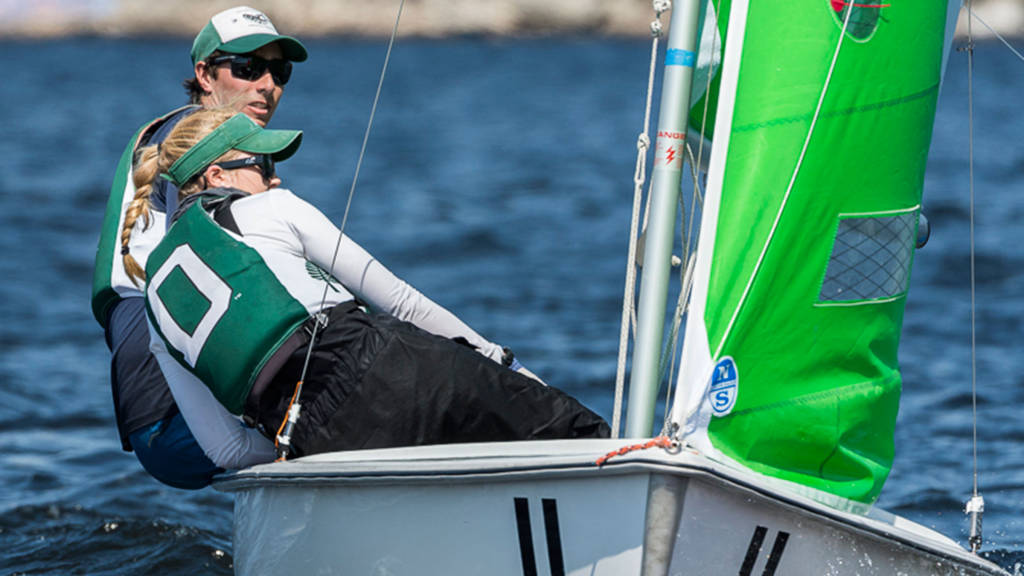
Duncan Williford had a solid season sailing B-Division for the team. The senior is a great leader and clearly has the stuff to compete. “Duncan grew as a teammate and an individual last spring, at the ready to help the team however he could,” said Assad. “He has studied the game carefully and will be ready for this spring; with crew Paige Clarke he has superb boathandling and his knowledge and ability to recognize situations will be a big strength.”
But perhaps more importantly, Christopher Williford, a junior, has evolved from being a talented youngster to a legitimate college sailor of the year candidate. Williford is one of the fastest helmsmen in the nation. If the replacements to Floyd, Lalumiere, Cooney, Greason and Kerr can learn the game at a similar level, this team will be tough to beat due to senior leadership and the continuing improvement of their emerging star.
Roger Williams University
RWU was a middle of the road team racing team at the start of last season. Much has changed since then. Now senior, Mack Bryan is extremely quick, has a cool demeanor, and his boathandling is second to none. Martim Anderson is an extremely talented sailor and now in his fourth and final year in college, has a really good grip on the intricacies of the game. Finally, Connor Harding has the edge needed when things get tight in a must-win race. Those guys coupled with great crews, a staple of any great Roger Williams team, are primed to make a run late this spring.
“We foster a love of team racing.” said Head Coach, Amanda Callahan. “Our top crews learn the nuances of the game in the same way the skippers do, so they anticipate the next moves and they feed the pertinent information which helps with great boat handling and communication.”
Seniors, Rebecca Anderson, Michael McBrian and juniors Jennifer Agnell and Halie Repeta will be the crews leading this rendition of great team racing at Roger Williams. This team is suddenly weathered and hard, especially with coaches Amanda Callahan and Colin Merrick, team race legends in their own right, pressing the buttons throughout the season.
They were on the outside looking in after last year’s Fowle Trophy, NEISA’s conference championship, finishing only 2 losses behind Boston College and a spot at the Championship in Charleston. This experience seemed to have lit a fire under the team.
Throughout the offseason, the starting team got together and sailed several open team race regattas, including the US Sailing Hinman Championship, America’s Team Race National Championship. At that event, this team was not “middle of the road” competitive, they were a contender to win the regatta throughout the event.
“In the six week team racing season, top college sailors might get an average of 78 races if they are lucky,” continued Callahan. “By competing outside college on the revived summer circuit, they essentially got an entire extra season of racing. And to get good at team racing you have to do a lot of reps.”
They have the speed and the grit now to get it done, a year matured. Do not be surprised if this team finishes atop NEISA and end up in the hunt for the championship in late May.
“Our top team’s passion for sailing and getting better at sailing has made this the most fun team to coach in my tenure at RWU. None of them had done much team racing before college. They’ve really worked hard TOGETHER; they are a group who really enjoys being together and you can’t force that chemistry. I’m grateful for it.”
Old Dominion University
A very young team last year, ODU showed the skill and maturity to sneak in after a competitive Prosser Trophy, the Mid Atlantic Team Race Championship. They are a year older now, a year wiser. A team that finished tied for 9th in the nation, brought back all but one sailor, Gabe Smith. There is little doubt that ODU will be better this year. However, being better does not guarantee an improvement in the standings, it doesn’t automatically qualify you for the top-8 and in a conference like the Mid-Atlantic, it doesn’t necessarily offer you a seat at the table.
Like NEISA, MAISA is allotted only 4 spots. If Georgetown and HWS take the expected steps towards final-4 caliber status, the young-but-improving teams like ODU, Navy, St. Mary’s, George Washington, Cornell and the Merchant Marine Academy will have to battle for just two spots with Georgetown and HWS claiming the top-2 spots in the conference. To emerge from the crowd, a team like ODU will have to continue to improve, take care of business by beating teams who they’re better than and take a race or two off of the elite teams.
George Washington University
Do not sleep on the Colonials. This team might not have been anything more than a club team with only aspirations of merely fielding a team race team 5 years ago. Much has changed in the past half-decade. With the work of dedicated alumni, especially Will Ricketson, coach John Pearce to help shepherd them onto the scene, current coach Billy Martin and talent such as Kai Friesecke and Miranda Bakos this team has more than arrived. Expect Kai to lead Andrew Sheerin & Derek Poon-Tip to the brink of qualifying for the national championship. An emerging national contender from MAISA, this team is primed to take the next step.
Photo provided by Rob Migliaccio
Massachusetts Institute of Technology
Ty Ingram is really fast. Trevor Long is extremely hard working, his improvement over the past 3 years is inspiring. Both seem like quality fellas and have adopted college sailing’s best corinthian spirit and skills. Shameena Shaffeeullah, Marcus Abate and Julia Cho are progressing towards some of the best crews in the nation, especially Ms. Shaffeeullah. This team finished 8th in last year’s championship without the help of now clear #2 skipper, Trevor Long, who then was recovering from a concussion. Cutter O’Connell filled in admirably as the team was not only able to qualify out of a stiff NEISA conference, but sail well in the championship. Fully healthy now and better due to the growth of their starting sailors, this team is ready to go. The question for this group seems not to be how will they get there but rather, who will stop them.
Eckerd College
Benefiting from sailing at one of the best venues to team race, Eckerd improved dramatically last season. They will look to continue to improve with goals of making the top-8 next season. The loss of senior Jason D’Aostino, William McKenzie as well as Assistant Coach Zack Marks will not help things. They first must look to fend off a surging University of South Florida and Jacksonville University.
Are there more teams that can, or will contend? You bet there are. Stay tuned for Part II, which will look at seven more teams, mostly riding dark horses, that have a chance to end up on top.
Feel free to post your thoughts in our discussion forum below this article!
ABOUT SAIL1DESIGN
Sail1Design is a grassroots organization, by sailors for sailors, dedicated to the youth, high school, college, and one-design sailing communities. Born in 2007, Sail1Design has grown considerably, and reaches out to all sailors wishing to enjoy and learn more about our sport. We have three main areas of business:
SAILING/MARINE INDUSTRY CAREER CENTER & JOB BOARD
We offer sailing’s #1 Career Center and Job Board, always chock full of incredible sailing job opportunities. Our comprehensive career center also offers job seekers the ability to create their own web page, highlighting their experience and posting their resume. Likewise, employers can search our resume database to find the right match for that open position. Sail1Design is proud also to be the official job board of the Intercollegiate Sailing Association (ICSA), the US High School Sailing Association (ISSA), and US Sailing.
MARKETPLACE & PROFESSIONAL BROKERAGE
Unique to the industry, Sail1Design hosts and manages an active private, by-owner marketplace, focusing on performance and one-design sailboats & gear. For all boats under 25′, our ads are free. What makes us different is that we also provide, side-by-side, professional brokerage services as well. We have had great success helping our sailing clients market and sell their boats, using our powerful client base, social media, and the brokerage industries multiple listing service to ensure your boat gets noticed.
AIRWAVES NEWS & CALENDAR
S1D also hosts Airwaves, an interactive, user fed Sailing Calendar and informative Sailing News, Articles, tips, & more. Airwaves has developed a great niche in the sailing publication world, and now boasts a seven-member staff of dedicated sailors, all contributing to our varied content.
Club Profile: Sachem's Head Yacht Club
News Flash: Sachem’s Head YC is Hiring a Race Coach!!
Sachem’s Head Yacht Club (SHYC) is located on the Connecticut shore of Long Island Sound, in Guilford, Connecticut. The clubhouse near the Thimble Islands, serves an active racing fleet and is a summer base for families and juniors involved in sailing, swimming and tennis. The club was founded in 1896.SHYC’s JR Sailing Program is a successful sailing program with approximately 60 sailors from ages 6 to 15. The program’s strengths are in fostering a love of sailing and respect for the water; teaching sailing, seamanship, and racing; and inspiring kids through fun, learning, and growth.
Our classes include sea-squirts, beginner sailing, adventure sailing, intermediate sailing, and Opti and 420 racing. Our fleets include 30 privately owned Opti, 10 OpenBICs, nine c420s, paddleboards, and a strong adult racing fleet of Lasers and Sonars. We are exploring the option of adding RS Fevas for summer 2018. Our Junior Sailing Coaching team is comprised of six paid instructors and a five volunteer “junior instructors in-training”. STEM/REACH modules are integrated into many of our classes. Our coaching motorboat fleet includes RIBs and 13’ Whalers.
Our program runs for 8 weeks, from late-June to mid-August. We offer housing on-site at our yacht club for up to 4 instructors each summer. Pay is competitive and based on experience.
Photos from summer 2017 can be viewed here: https://kerryschutzphotography.pixieset.com/shycsummer2017/
A BRIEF HISTORY OF THE SACHEMS HEAD YACHT CLUB
Whenever two sailboats meet , there is always a race , even if it is only in one of the cockpits. Such was the case in those formative years in the late 1800’s. The Club was founded in 1896, and the flag was designed in1897. The SHYC Corporation was founded in 1898 in order to fund and build the Clubhouse. Building activity went on with additions till 1901. In 1902 a windmill and ‘water tower’ were added. Various races ,regattas, and cruises were held from Rhode Island to New York. The breakwater was started in 1908 , “and the rock sunk into the mud as fast as it was dropped overboard”. The Hurricane of 1938 took off the top floor of the Clubhouse , and gave us the structure we basically have today. There have been any number of classes raced at the SHYC. There were the ‘Sachem Headers’ , a gaff rigged boat. There have been Zips , Stars , Eastern Interclubs , Lightnings , and the many classes racing today. The Sachems Head Yacht club prides itself on being a sailing club with a great ‘junior program’ to continue this tradition.
-Past Commodore Peter Johnson
Airwaves Job Board & Career Center: Not Just for Coaching Jobs Anymore
Sail1Design pleased to offer the sailing community our popular sailing job board, rich with summer, and full-time coaching opportunities. In our 10 years of business, however, our job board has grown into a full-fledged sailing/marine industry career center, with full-time, year-round positions available for those seeking opportunities or a career in the sailing/marine industry.
Our resume database features outstanding young and experienced talent. While wishing our clients a Happy New Year, we also invite you to see us in a new light: your path to a new career! Employers, invest in our Airwaves Career Center for your hiring needs; you will be glad you did!
SAILING/MARINE INDUSTRY CAREER CENTER & JOB BOARD We offer sailing’s #1 Career Center and Job Board, always chock full of incredible sailing job opportunities. Our comprehensive career center also offers job seekers the ability to create their own web page, highlighting their experience and posting their resume. Likewise, employers can search our resume database to find the right match for that open position. Sail1Design is proud also to be the official job board of the Intercollegiate Sailing Association (ICSA), the US High School Sailing Association (ISSA), and US Sailing.
Club Profile: Housatonic Boat Club
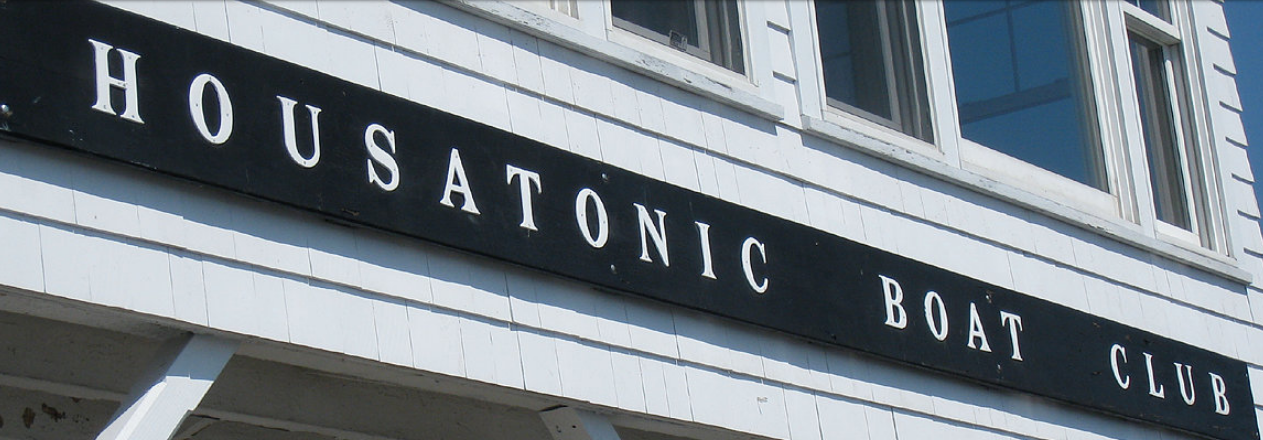
HBC, THE OLDEST ACTIVE YACHT CLUB IN THE STATE
On January of 1887 seven Stratford men, John and Frank Benjamin, Frederick C. Beach, Henry Parson, The Wheeler brothers and George Strong, met to form a club for, as our charter reads “ …social intercourse, and to promote and encourage an interest in yachting.” and the Housatonic Club was formed. By April of that year its two-story clubhouse was raised on pilings at the edge of the river channel on the property of Alfred Ely Beach, Frederick Beach’s father and publisher of Scientific American. The site was chosen for its commanding view of the river, and an easy reach up or down the river in the prevailing southwesterly breeze.
JUNIOR SAILING PROGRAM
The Housatonic Boat Club’s Junior Sailing Program offers youngsters (ages 8 to 16) an opportunity to learn the basic skills of sailing and to gain more proficiency as they advance as serious competitors or recreational sailors. Our capable and experienced sailing instructors are US Sailing certified and teach the fundamentals of seamanship from wind direction, the river’s current, sailing rules and racing 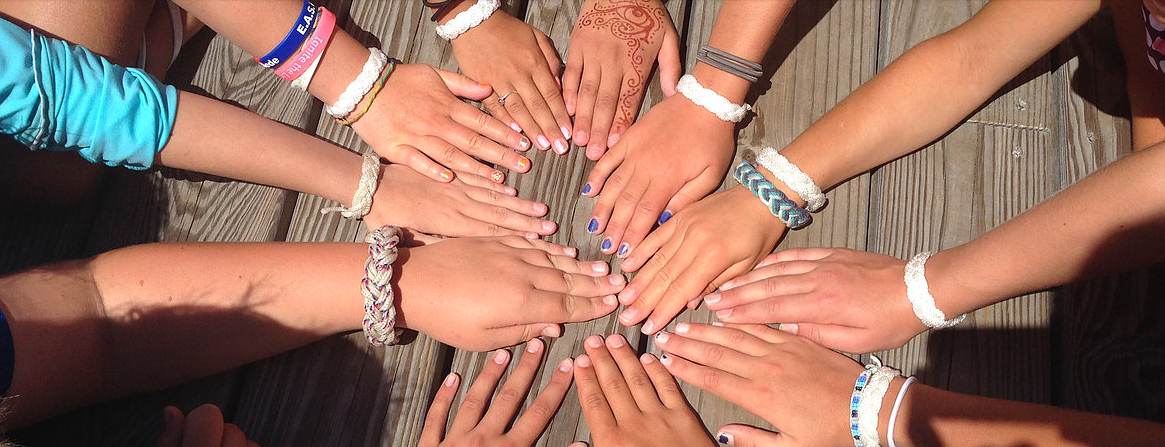
News Flash: The Houstonic Boat Club is hiring a Sailing Director, & Sailing Instructor Positions!
HBC, THE OLDEST ACTIVE YACHT CLUB IN THE STATE
The Housatonic Boat club is in its 129th season – the oldest active yacht club in the state! In January of 1887 seven Stratford men, John and Frank Benjamin, Frederick C. Beach, Henry Parson, The Wheeler brothers and George Strong, met to form a club for, as our charter reads “ …social intercourse, and to promote and encourage an interest in yachting.” and the Housatonic Club was formed. By April of that year its two-story clubhouse was raised on pilings at the edge of the river channel, at a cost of $1,204, and a 200-foot catwalk stretched across the marsh to the riverbank, on the property of Alfred Ely Beach, Frederick Beach’s father and publisher of Scientific American. The site was chosen for its commanding view of the river, and an easy reach up or down the river in the prevailing southwesterly breeze. On 21 May forty-one members held an organizational meeting, and at the official dedication of the clubhouse on the Fourth of July membership in the Housatonic Club totaled fifty-one. John Benjamin, owner of Benjamin J & Co., an early member company of the New York Stock Exchange, was elected first president – the only one ever elected by the general membership – and held that office until his death in 1906, when Frederick Converse Beach succeeded him.

HURRICANES
Storms, ice, hurricanes, and tides have always been a threat to HBC. The disatrous hurricane of 21 September 1938 drowned the Lewises and wiped out their Thimble Island cottage only a week after Club boats visited them; water at the Club rose two feet above the deck. But the worst property damage of all resulted from the surprise hurricane of 1950. Fortunately the clubhouse had been moved onto new pilings in 1948, and the main deck was loaded with twenty tons of mushrooms being winter-stored: it was the only structure to survive. All else was demolished – bathhouses, lockers, floats, even the 200-foot catwalk across the marsh to the bank. Everything had to be rebuilt. But with a bond issue to the members and the work of many eager hands under the skilled direction of Bud Olsen, the Club was soon better than ever, with a new sailhouse and a new bathhouse, and in 1960 a kitchen. But again in 1955 hurricane floods in August and September raged down the river. A derelict barge tore loose and swept through the fleet. Boats picked up their mushrooms and floated out to sea. The river dredge Arundel flipped onto its side across the channel near Crimbo Point, crushing boats swept against it and blocking the Channel for two years. In all, seven HBC boats were destroyed.
Later hurricanes spared us, until the 1985 storm ruined floating equipment and severely damaged docks, again requiring members to rally and repair.
LAND TROUBLE
HBC’s greatest threat was not the weather. In 1952 the Club learned that the land, then in trusteeship to a bank, was about to be sold. A special committee, Ira Peterson, Ray Baldwin, and Al Beach, presented a plan to form a syndicate of members to purchase the Beach estate for the Club. Housatonic Properties was incorporated by nine members, and on 19 March 1954 they bought the whole property, then sold the uplands to the American Shakespeare Theatre with the stipulation that it never be used commercially, and on 17 May 1954 deeded the eleven acres of marshes and the road to the Club. After 67 years, the Club finally owned the land on which it sat.

At the start the fleet included cats, cutters, cat-ketches, and sharpies berthed in slips, with kayaks, canoes, and Whitehalls on the floats. In 1888 James Leavitt introduced the first power boat – a Naphtha launch – which did not require a steam engineer on board, and soon the Beach family owned one, too. Bedell Benjamins’s steam yacht, with five-man paid crew, was too large to keep at the Club, so he tied it up at his own dock, upstream from Bond’s. Soon the first gasoline launches with one-lung engines, appeared.
FACILITIES
The Club’s facilities were intentionally spartan. In 1891 a bathhouse and a sandy beach, reached by a 160-foot plank walk along the edge of the marsh, provided a spot for swimmers. In 1893 John Beach’s studio was floated in for use as a men’s bathhouse. A winter project to lengthen the clubhouse was completed in time for the 9 May 1896 Club opening. Until 1933 oil lamps provided light. Running water came in 1946, when pipes were laid across the fields to Elm Street every spring, and taken up each fall. A one-hole p
CLUB PARKING AND STORAGE
In 1956, although the pristine marsh and catwalk made the decision difficult, the need for Club parking and boat storage demanded that the property be developed. Fill was obtained from the state highway department and local industries for the yard and the road, and both were raised. In 1975 the town offered to oil the road (which belongs to the Club) and in 1977 the yard was fenced. In 1994, the year of the great asbestos scare, DEP spread an impermeable cap across the yard. Then in 2000 the federal EPA further elevated and capped the land, added shoreline rip-rap, paved the boatyard, and fenced and landscaped the property. With a whole new look and with new water and sewer line connections, the Club enters a new millennium.

Much has changed since we toasted this new century. Not only have we adjusted ourselves to the new regulations of the later part of the 1990’s, but also we have enlarged our membership and our fleet, both in length and numbers. Our grounds were dug and capped by the EPA. Opening Day was held “off-campus” that summer, and early on we traveled to and from the mooring field from Birdseye Fishing Dock. A boat barn was constructed so that the members could spend the winters maintaining the club’s launch, Junior Sailing fleet and workboat. The clubhouse had new steel pilings installed to replace the wooded ones that were put under the house in 1979. The launch operator’s office was constructed in place of a few of the sailing lockers. Old windows were replaced with new ones and a new awning was installed to protect us against the elements. Yes, we move along, thanks to the unique Corinthian spirit of our membership.
Historical Information extracted from Club’s former Commodore Lew Knapp in his book Stratford and the Sea

Club Profile: Community Sailing of Colorado
By Airwaves Senior writer Taylor Penwell
An Interview with Executive Director Brandon Kass
What is the Community Sailing of Colorado?
We are a nonprofit organization committed to make sailing accessible to all in Colorado. Our programs impact the Front Range Colorado communities through a variety of programs including adults classes, youth camps, junior race team, low to no cost adaptive sailing clinics, and free open house sail nights from April-October. In our mountain-based region, water is one of our most valuable resources. We are proud to be an organization that works hard to share a scarce watersport, such as sailing, with everyone we can.
How did Community Sailing of Colorado get its start?
Our founder Steve Frank wanted to provide access to sailing for children in Colorado after transplanting from the Boston area. His idea of CSC came from Community Boating, Inc., in Boston, where he learned to sail and found a passion for the sport. After moving to Colorado, he began soliciting donated boats and received a few old sailboats to run a couple youth sailing camps. This expanded into a full summer programs and eventually grew out of its initial location and moved into the Cherry Creek Reservoir. Community Sailing of Colorado was officially founded in 1994. Since 2010, we added new programs for adults and an adaptive sailing program for individuals with disabilities. In 2014, we added a second location in Boulder, CO and have ultimately doubled our programming.
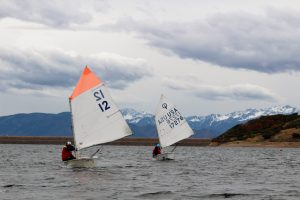
“Make Sailing in Colorado Accessible to All. Teach Skills, Build Confidence & Have Fun!”
What does CSC offer its members and the community?
Summer camps for kids, adult sailing classes, free weekly open house nights, free weekly adaptive sailing clinics, a beginner friendly competitive social sailing league, low to no cost outreach programs for partner organizations who serve at-risk populations and low to no cost adaptive programs for groups working with individuals living with disabilities,
Who is Brandon Kass and what changes have you made at Community Sailing of Colorado?
I grew up in a sailing mecca in the state of Iowa;). I was fortunate to have a public sailing club on the lake my family had a summer cabin on. At age 8, my siblings and I spent our first summer sailing with the Okoboji Yacht Club Sailing School. Lake Okoboji has a long history of racing scows and I quickly began racing as well. Ultimately, I became an instructor, coach and director of that program. After my first year of college, I had an opportunity to move to Southern California where I immersed myself in the sailing scene. I was fortunate to work with the Long Beach Yacht Club, Lido Isle Yacht Club and ultimately with a public sailing center called the Leeway Sailing Center in Long Beach, CA. This is where my love for a community program really developed by providing sailing for underprivileged youth in the area. After 7 years working and racing in California, I moved to back to Iowa to complete my degree. After that I found myself in Denver working in the hospitality industry when this opportunity of executive director of CSC came about. I jumped at this unique opportunity and haven’t looked back. I still race (and own) scows competitively on my home lake when I can and also race keelboats in Colorado and around the country.
Here is a bit more about Brandon Kass from a previous publication.
At the helm is Iowa native Brandon Kass, who grew up sailing on Lake Okoboji in the “Iowa Great Lakes.” He became an instructor at age 15 and had the opportunity to learn under the direction of Rob Coutts, older brother to acclaimed Olympic, America’s Cup and professional sailor Sir Russell Coutts. Then at age 20, he relocated to southern California, where he worked for the Lido Isle Yacht Club in Newport, the Long Beach Yacht Club and the Leeway Sailing and Aquatics Center.
After seven years on the West Coast, Kass returned to Iowa to finish college and pursue a career in hospitality with Marriott Hotels, a position that took him to Denver. And in 2010, that’s where his passions for sailing, teaching and providing access to the water took hold of him once again: A small local nonprofit was looking for an executive director to help run its summer sailing programs for a couple hundred kids.
Kass seized the opportunity, and under his leadership, Community Sailing of Colorado has experienced startling growth. When he started, the nonprofit served roughly 200 kids each season. Today, it serves almost 3,000 people annually.
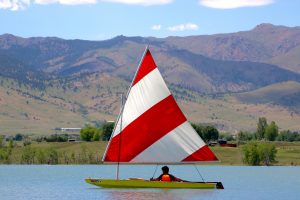
“Community” is the most important word in our title and it is exactly how we would describe our sailing scene. We are a nonprofit, non-yacht club, and non-membership based organization that truly values our community as a whole and we are incredibly welcoming to anyone and everyone who is even remotely interested in sailing. On any given day you may have a 5 year old out sailing at camp and turn around to see a 15 year old racing mid-afternoon followed by a 65 year old learning how to sail for the first time. One of my favorite things about CSC is when our programs merge and we have some of our Junior Race Team helping with an adaptive sailing night. To watch as perspectives grow and to see an appreciation for sharing a passion with someone new take shape, truly embodies what our community is all about.
Tell us about the Junior Sailing Programs
Our Junior Sailing scene is a combination of a few programs. We run summer camps that during the day for kids 5 – 17 years old. Then a couple afternoon each week we have a competitive optimist race team as well as a high school race team that sail from early April to late October. In addition, during the spring and fall we also offer an After School Adventure Sailing class for our juniors who are interested in learning to sail or even hone their skills.
Where are you located?
Colorado! No really, it’s true. Cherry Creek Reservoir (12 miles south of Denver) and Boulder Reservoir (3 miles northwest of downtown Boulder)
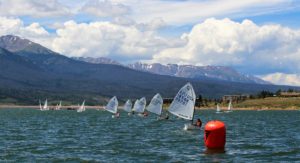
We have a huge gala fundraiser in the spring where we gather about 200 people from our community together for an incredible evening that includes an open bar, plated dinner, silent auction, live auction and fun activities (hint: this year we’re getting a mechanical bull!) It’s an awesome night and something to look forward to each year. We also have a movie night where we rent out a theater and screen a sailing related movie for our community. In year’s past we’ve had someone involved in the movie Skype in for a live Q&A post screening, which is really fun. This year COYOTE is the film of choice and we’re really excited about it. Other possibilities that aren’t nailed down yet are a trivia night, and bingo brunch.
What sailing events are on the schedule for the upcoming season?
- 19th Annual Spirit of Sailing Gala Fundraiser | April 14, 2018 | Denver, CO
- US Sailing Rocky Mountain Junior Olympic Festival | August 10-12, 2018 | Cherry Creek Reservoir
- Boulder Junior Regatta | August 26 | Boulder Reservoir
- Year End Fundraiser & U Gotta Regatta | September 8 | Cherry Creek Reservoir
Is there a weekly race scene?
We have a beginner-friendly competitive sailing league that runs two 5-week series in the summer at our Denver location. This is made possible through our partnership with Play Mile High. In addition, our sister organization, Denver Sailing Association, runs Wednesday night keelboat racing and Thursday night dinghy racing at Cherry Creek Reservoir.
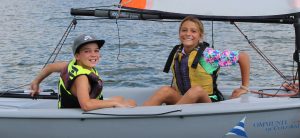
Everyone should have access to sailing regardless of financial, physical or mental barriers. Community access to sailing is what drives our programs and is something we hold in very high esteem. We feel that sailing should not be an elite sport in which only a select few can participate given the inherent financial constraints. This is why we provide free weekly open house sailing nights for anyone to come out and enjoy. In addition to eliminating financial barriers we work very hard to ensure that our community members living with disabilities have the opportunity to go sailing at low to no cost as well. We host free weekly adaptive sailing clinics for individuals with disabilities and their friends or families to enjoy time on the water.
What would you tell someone interested in joining?
There is sailing in Colorado, and lots of it! If you are interested in learning how to sail, we can take care of that! We have sailing programs for children, adults and individuals with disabilities. Come try out sailing during one of our (12) free sail nights throughout the summer. This is an “open house” style event where one of our staff or volunteers takes individuals and families for a sail while providing some basic instruction. We also offer a junior racing program for those young sailors wanted to take their game to the next level.
Where do you see the organization in the coming years?
We would like to continuing building our adult programs and strengthening our junior programs. The next frontier for us is to continue to offer new adult programs that engage millennials, one of the fast-growing age groups here in Colorado. Eventually we would like to host adult racing classes for our sailors to transition into the local racing scene. Our hope is to also see our Adaptive and Outreach Sailing Programs expand and build new relationships with even more service-oriented organizations. One dream of ours is to host an inclusive regatta where all our sailors (abled and disabled) will race against each other and we don’t feel we’re too far away from making that happen.
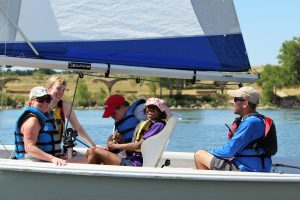
Community Sailing of Colorado—CSC—has enjoyed over 22 years of teaching sailing on Colorado lakes. CSC was established in 1994 and soon after began teaching sailing on Standley Lake in Westminster, CO. The organization was created by Steven Frank, who recognized a need for a well-structured program to educate kids in the Denver area through sailing and water activities.
Today, CSC hosts sailing camps and classes for all ages across the Front Range from April through October each year. Throughout the summer, CSC offers weeklong Learn to Sail, Intermediate, and Advanced Sailing Camps along with Little Puffs Camps for first time sailors; allowing youngsters develop sailing skills in fun and challenging ways. Camps are conducted at the Boulder and Cherry Creek Reservoirs. We also host a growing Junior Racing Program to hone advanced sailing skills and techniques for those looking to compete in local, regional and national competitions.
Over the years, CSC has shared the joy of sailing with over 15,000 students since its inception with many of them receiving scholarships to participate in our programs. We pride ourselves on the countless number of community outreach events and free sailing opportunities we’ve held over the years. These opportunities allow us to partner with community organizations and share the joy of sailing with those who might not otherwise have the opportunity.
In 2011, CSC purchased two Access 303 Wide-Seater Dinghies, boats specially designed for adaptive sailing. This launched our Adaptive Sailing Program for individuals with physical and mental disabilities and set our organization along the path of developing this program to reach everyone in our community. Our Adaptive Sailing program has grown throughout the years to reach over 500 people in Colorado just this season. This is due to the many community partnerships serving individuals with disabilities. Our challenge as an organization is to continue to “Make Sailing in Colorado Accessible to All. Teach Skills, Build Confidence & Have Fun.”
Sail1Design's Marketplace: A Resource for Sailors for 10 Years. Get your Holiday Gift!
As a gift tot the entire sailing community, we are offering free ads at ALL levels for the holiday season! Use the coupon “getitsold” and your ad, no matter how bog your boat, or featured, will be free!
10 Years Serving the Sailing Community: So Far, So Fast
Unique to the industry, Sail1Design hosts and manages an active private, by-owner sailing classifieds & marketplace, focusing on performance and one-design sailboats & gear. For all boats under 25′, our ads are free. In fact, we are the official classified site of the US Optimist Class (USODA) and the US 420 Class. Over our first decade of business, we have helped thousands of sailors connect with fleets of boats, RIBS, sailboats, gear, and more. Our mailing list covers most all clubs in the country, and we are actively involved in youth, high school, college, and adult one-design sailing. Take advantage of our experience, connections, and exposure!!
If your class would be interested in taking advantage of our services, please contact us. We work hard to help sell your boats, promote your class and make sure your needs are met. We would make a separate category just for your class!
What makes our sailing classifieds different is that we also provide, side-by-side, professional brokerage services as well. We have had great success helping our sailing clients market and sell their boats, using our powerful client base, social media, and the brokerage industries multiple listing service to ensure your boat gets noticed. Our brokerage has a national reach, and we have been very successful for our clients.
As a gift tot the entire sailing community, we are offering free ads at ALL levels for the holiday season! Use the coupon “getitsold” and your ad, no matter how bog your boat, or featured, will be free!
Tabor Academy FJ Fleet For Sale
- Viper 640 For Sale in FL, $15,000
- i420 For Sale, N. Carolina, $4000
- Fleet of 8 420’s For Sale, Charleston, SC
- Fleet of 22 Hunter Xcite Sailboats for sale, MD
- 3 JY15 Sailboats for sale, MD
- Laser For Sale, NY, $1500
- J/22 # 698 For Sale, Annapolis, MD, $7000
- Alerion Express 28 For Sale, CA, $69900
- c420 For Sale, almost New, Marion MA $9500
- 2014 McLaughlin Optimist, Naples, FL, $1400
- 2010 Laser, Sloatsburg, NY, $3800
- 13′ RIB with Honda 30hp Motor, RI $1500
- C&C 30 One-Design, CA, $149900
- Vanguard 420, Coronado, CA, $2500
- Vanguard 15, Huntington, NY, $2500
- Zim Club 420, St. Augustine, Fl $8900
- Fleet of 10 Club 420′s, Boston University, MA
- 3 Zim 420’s For Sale, RI
- A-Class Cat, VA, $1000
- Fleet of 6 FJ’s For Sale, Hotchkiss School CT
- Fleet of 9 420’s For Sale, Hotchkiss School, CT
- 2015 International 420 Nautivela, NJ, $11000
- Zim Black c420, #6121, ME, $7200
- 3 Club 420’s For Sale, Bristol, RI, $13000
- 2014 McLaughlin Optimist, VA, $2750
- 29er, CA, $3000
- Blueblue i420, Cape Cod, $7500
- Custom 24ft. Racer, FL, $7500
- 2008 club420, Jamestown, RI, $3500
- Fleet of 6 2003 Flying Junior Sailboats
- Fleet of 6 Collegiate FJ’s For Sale
- 2008 Vanguard c420, RI, $3500
- RS Aero For Sale, 20155, Lightly used! TX
- Blue Magic Optimist, MD, $3100
- 2003 Vanguard c420, RI, $4200
- Vanguard 15 with Trailer, CT, $3500
- 29er USA-1838, Annapolis, MD, $5500
- J/111 For Sale, Price Reduced. CA
- Lange High Performance Optimist, ME, $2250
- ZIM c420, NJ, $9250
- RS VISION, MO, $11500
- 2016 McLaughlin Race Optimist, CA, $2195
- 2003 LASER, #177328, FL, $2300
- 2017 ZIM c420 with Trailer!, NJ, $10000
- Coronado 15, OR, $1000
- Sailing Pavilion Available in Boston!!
- McLaughlin Pro Racer Optimist for sale. Fast Boat, Great Race Record, MD, $3800
- 2 Race Ready Lasers with Custom Trailer, MA, $14500
- Vanguard C420, Clearwater, FL, $5000
- 49er for sale, IN, $2500
- Laser VAGO, IN, $8500
- J/30 For Sale, CA, $24,900
- Winner Optimist, DE, $2500
- 2010 LP c420, MA, $7500
- OPEN 5.70 For Sale, Sausalito, CA, $15,000
- ZODIAC PRO OPEN 550, WI, $35,000
- Fleet of 8 Hobie Getaways! CT
- Fleet of 9 Hobie Waves!, CT
- 20 LASERS for SALE!!, Westport, CT
- Whitecap Composites Collegiate 420, LIKE NEW, MA, $7400
- PS2000 29er, Falmouth, MA, $6500
- Fleet of 4 Club 420’s For Sale, Newport, OR
- 470, Jensen Beach, FL $1200
- Fleet of 4 Hobie Waves, Jensen Beach, FL
- Winner Optimist, Naples, FL, $1600
- McLaughlin Pro Racer, Center I., NY $3000
- 420 Double Stack Trailer, St. Petersburg, FL $2500
- Like New Winner Opti, DE, $2550
- J/22 #698, Annapolis, MD $8500
- FLEET OF 7 Zim C420’s! RI
- I420 in Excellent Condition, Riverside, CT, $5200
- 2004 Vanguard Laser, NY, $3200
- 2005 Laser, SC, $3500
- 2008 Vanguard 15, MD, $2700
- 4 Boat 420 Trailer, Charleston SC, $4000
- Winner Optimist, Annapolis, MD $2100
- Blue Magic Optimist, Annapolis MD, $2950
- Fleet of 3 Club 420’s for sale, Bristol, RI
- LaserPerformance 420 USA-6627, Marion, MA, $8999
- 2015 Nautivela i420, Stamford, CT, $10,000
- Blue Magic Opti, Little Silver, NJ, $2750
- ZIM Pro Optimist, Duxbury, MA, $2800
- Like New Winner Optimist, DE, $2750
- Beneteau First 30, CA, $89500
- Winner 3D Star Optimist, FL, $3300
- McLaughlin Pro Racer, FL, $2300
- 12 Seitech Dollies For Sale, CT, $250/ea
- OPTI/Laser 4 Boat Enclosed Trailer, Fl, $3200
- 2 RS Visions for sale, Bronx, NY, $7000
- 2012 ZIM c420 #7225, Marion, MA $7000
- Triple Stack DInghy Trailer, NY, $2800
- J/124 For Sale, Alameda, CA
- J/92 For Sale, CA
- 75′ IACC America’s Cup: Il Moro de Venezia
- J/133 For Sale, gorgeous boat!!
- J/160. What a boat!
- S1D also offers private, by-owner listings. Check us out!
SAIL1DESIGN MARKETPLACE & PROFESSIONAL BROKERAGE
Sail1Design hosts and manages an active private, by-owner marketplace& sailing classifieds, focusing on performance and one-design sailboats & gear
If you have a boat to sell, or are looking for a boat, let our experience and attention to detail go to work for you! Contact us today at [email protected] to learn more!
One Design News: Sonar North Americans heads to Noroton Yacht Club
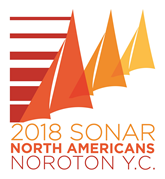
Over 40 boats are expected for four days of fun and fast sailing at one of the premier sailing venues and legendary one-design racing clubs on the East Coast. With direct access to Long Island Sound, coupled with September’s warm water and traditional 10-15 knot SW breeze, Noroton Yacht Club provides the perfect venue for a championship of this venerable Class. Sonars charters and limited housing are available. See NOR for details.
Noroton YC has excellent hoisting facilities to speed up launching and hauling, and will provide moorings for all competitors at no cost. There are many hotels within a 5-10 minute drive of the club. Noroton is also only 5 minutes from Interstate 95, and a 50-minute train ride into Manhattan, for those interested in pre- or post-regatta sightseeing.
Shoreside, Noroton YC’s new clubhouse will play host to a variety of social events, including a Thursday night welcome reception, Friday Night BBQ, and Saturday Night Dinner Dance.
Preliminary Schedule
Thursday, 9/13: 0800 to 1900 Launching and Registration
1430 Practice Race
1800 Competitor’s Meeting
1830 Welcome Cocktail Reception
Friday, 9/14: 1000 First Warning Signal
1830 BBQ Dinner
Saturday, 9/15: 1000 First Warning Signal
1830 Cocktails and Dinner Dance
Sunday, 9/16: 1000 First Warning Signal
Awards to follow racing (no warning signal after 1400 hours)
Regatta registration and information is available at: https://yachtscoring.com/emenu.cfm?eID=4554
The Notice of Race is at: https://sail1design.com/wp-content/uploads/2017/12/Sonar20NA20NOR202018.pdf
Online registration is now open at: https://yachtscoring.com/event_registration_email.cfm
And regatta gear can be purchased from apparel sponsor Team 1 Newport.
Two weekends after the Sonar North American’s, Noroton YC will host the annual Kirby Cup – The Sonar Class Association Team Race Championship.
Contacts:
General Information/Sponsorships Media
Scott MacLeod Michael Rudnick
[email protected] [email protected]
About Noroton Yacht Club
Noroton Yacht Club is located in Darien, CT. Founded in 1928, the club is dedicated to promoting family participation in sailboat racing and recreational sailing.
Noroton YC has a rich heritage of one-design fleet and team racing. Noroton members currently sail Sonars, Ideal-18s and Vipers, and the Club has a fleet of over 50 Cruising boats. Noroton members participate in Club racing as well as other local, regional, national and off-shore distance racing and cruising events.
Noroton members have competed at the highest levels of the sport, including the America’s Cup, Olympic campaigns, and Collegiate All-Americans. Noroton sailors won the Sonar Worlds in 2015 & 2017, well as title-holders of many prestigious Varsity, Masters and Grandmasters team race regattas in the past decade.
Noroton also has a large and well-respected junior sailing program for ages from 8 to 18, member and non-member children sailing Optimists, Pixels, Lasers and 420’s. Noroton also hosts the Darien High School Sailing Team in the Spring and Fall.
About the Sonar
The Sonar is a 23-foot keelboat, normally sailed with a crew of four, with a fractional rig and symmetrical spinnaker. The Sonar was designed by long-time Noroton YC member and legendary yacht designer Bruce Kirby specifically to meet Noroton YC’s requirements of a one-design keelboat for club-racing.
The first prototype Sonar was sailed out of Noroton Yacht Club in March 1980. The Class Association was formed shortly thereafter. And the Sonar obtained Recognized status with World Sailing as an international class in 2000. The Sonar was the three-person Paralympic keelboat from 2000 – 2016, and has become the boat-of-choice for team racing. Over 800 boats have been built, with fleets in six countries.
Norfolk Yacht & Country Club is Hiring!
News Flash: Norfolk Yacht & Country Club is hiring all levels of it’s 2018 Summer Staff!!
After successfully helping host the 2017 Optimist US National Championship, the Norfolk Yacht and Country Club continues to pursue its mission and offers wonderful sailing opportunities for the Norfolk, VA area community. I was able to gather some thoughts and observations of this great sailing club during my two-week stay. This is one great club!!
From Commodore Rick Sanford, “Norfolk Yacht and Country Club is a warm and welcoming Club where its member families and guests have unique experiences which create lifelong friendships and memories. Our first-class waterfront setting provides a wide-range of social activities and recreational facilities for member enjoyment and perpetuates a culture of camaraderie and fun among our members. NYCC also has a vibrant boating community with recreational and competitive sailing for sailors of all ages.” Our power boaters enjoy cruising our many waterways and the occasional ‘poker run.’”
BRIEF HISTORY
In the late 1890’s, a small group of citizens sought to establish a place where they might enjoy outdoor activities and the camaraderie of likeminded souls. On April 20, 1896, the group received a charter to establish the Country Club. Leaving the city, the founders leased property in the country, along the banks of the Elizabeth River, in what is now called Edgewater.
Although Norfolk’s city limits did not extend past the Hague at the time, the founders were convinced that others would be enticed to this rural setting to escape the congestions in the city and enjoy the amenities of the Club. The Club grew rapidly, and soon it was necessary to lease more land in order to expand the facilities. Six years later, however, it was apparent that the Club had outgrown this location. In 1902, the Club purchased a 35-acre site several miles downstream, near Sewells Point. A new, larger clubhouse was built, as well as four tennis courts and a nine-hole golf course.
During this time, new neighborhoods sprouted up in Riverview, Colonial Place and Larchmont. The primary access to them was by trolley or automobile. Unfortunately, the trolley service was not dependable, and the roads were often barely passable. The leaders of the Club soon realized they had made a mistake: The new site suffered from poor accessibility. Norfolk, on the other hand, had bold plans for a major redevelopment near this very site. Norfolk was set to be the host city for a seven-month celebration to commemorate the 300th anniversary of the Jamestown settlement. The site for the festivities was Sewells Point. The Jamestown Exposition sparked a surge in constructions as Norfolk prepared to welcome the rest of the country. The Club’s leaders, not wanting to miss an opportunity, sold its Sewells Point property in 1906.
A search for another, more accessible site was begun. In 1908, a location was selected along the banks of the Lafayette River. It was convenient to the trolley line and to the bridge across the river. It had ample space for the Club’s sports facilities, along with a magnificent waterfront view. On February 22, 1909, the Country Club opened with a new clubhouse, four tennis courts and a nine-hole golf course. In 1915, additional land was acquired to enlarge the golf course to eighteen holes. The golf course, regrettably, was short-lived.
As the country prepared to enter World War I, Norfolk’s leaders worked to persuade the US government that the former exposition site was an excellent center for military operations. In early 1917, the Navy leased space in a downtown office building as the headquarters of the Fifth Naval District. It wasn’t long before the Navy decided that it had to have the exposition site, and it bought the property for almost $500,000. To support the war effort and Norfolk’s growing importance as a military center, the government needed part of the Club’s new golf course for a cargo terminal. The Country Club had to give up the land that today is known as Norfolk International Terminals. About ten years later, the Club sold the remainder of its golf course; that land became Lochhaven.
In 1923, Norfolk annexed a huge tract of land that included the Country Club, and, for the first time, the Club was within the city limits. In 1927, in deference to this fact, the Club voted to change its name to the Norfolk Country Club. Within a few years, the Club attracted the attention of yachtsmen who believed that the waterfront location was an excellent place for a marina. In recognition of this popular new addition to the Club’s activities, the Club changed its name once more in January, 1936, to the Norfolk Yacht and Country Club.
In just 40 years, the little Club founded on a small, leased site in Edgewater had become a prominent fixture on the banks of the Lafayette River. In these early years, the Club flourished and faltered, reflecting the fortunes of its membership and the city at large. The next sixty years were times of unparalleled growth for both Norfolk and the Club. Surely, there were more bumps along the way, but Norfolk and the Club prospered under the leadership that had the vision to dream of great things and the courage to implement them.
HERE AND NOW
Ever conscious of our impact on the river, we have a large contingent of members who participate in the Clean the Bay Day every year. We clean our waterfront and the western waterfront of the Norfolk International Terminals where we collect hundreds of pounds of junk. The Club is an Elizabeth River Project “River Star Business” for our voluntary pollution prevention and wildlife habitat enhancement (we incubate several baby oyster hatcheries). We are also a “Virginia Clean Marina” for our voluntary adoption of measures that prevent or reduce pollution.
NYCC hosts High School sailing in the Fall and Spring seasons in the fleet of Flying Juniors and the Club’s coach boats. Three local schools: Norfolk Collegiate, Norfolk Academy and Maury High School share the boats every weekday to practice and most weekends NYCC hosts (actually, one of the 3 local schools host) a regatta. Regional, State and even National high school regattas find their way to our facility. With the prevailing wind from the SW, the club provides an excellent viewing venue for fans and parents to witness “up close racing” without venturing into the elements (this is most important in November and March). Many of our local sailors have reached high school all-state and all-American levels. Many have gone on to race at the collegiate level and beyond. NYCC sailors have also reached the Collegiate All-American level.
The Club’s Junior Sailing Program is the oldest running summer program at the club; with a rich history, spanning over 65 years, the junior program boasts an array of alumni and coaches that range from CBYRA champions, to College All-Americans, and even an Olympic Gold Medalist! The six-week summer camp features the International Optimist Dinghy and The Flying Junior sloop, and offers classes for all skill levels. Sailors range from 8-18 years old and do not need any formal training prior to enrollment. Give your child the unique opportunity to make new friends, learn to sail and gain confidence and independence on the water. Each year we have nearly 100 young sailors participate. Sailing is a sport for life!
Junior Sailing isn’t all about regattas and trophies. Every day at NYCC Junior Sailing Camp incorporates fun activities for all ages and skill levels. While boat handling, safety and wind/weather provide a lot to be learned, Instructors also incorporate fun elements into the daily routine to maximize camper enjoyment. On and off the water, NYCC Junior Sailing Camp provides a great balance of learning and fun.
The oldest, most tradition-rich regatta hosted by NYCC is The Governor’s Cup. Traditionally held on the Saturday of Labor Day weekend, it is a regatta rich in history which we have hosted for the past 73 years for the Hampton One Design class. The cup itself can usually be found behind the bar in the Lafayette Room of the Main Clubhouse and is a stunning work of art in and of itself. The following description of the Governor’s Cup is pulled from a regatta program produced by NYCC in 1979 and provides insight on how the cup came to exist: The Governor’s Cup (Virginia State Championship for Hampton One-Designs). After the last series of races of the Norfolk Yacht Racing Association in late August of 1944, it was the desire of the Commodore to establish a Virginia State Championship trophy for the Hampton One-Design Class sailboat. 
We also have a ‘big boat’ program with Spring and Fall Friday evening Races for the PHRF racers. We host the CBYRA-sanctioned New Willoughby Challenge in July of each year with a course set in the Hampton Roads with a picnic afterword.
FUTURE
The Club is set to embark upon a new capital improvement plan which will be a multi-million renovation and expansion of our current dining and social venues, upgraded the tennis facility and tripling the size of the dock house among other improvements. The Junior Sailing program has a goal of continued excellence in instruction and to expand the youth sailing instruction season into the Spring and Fall months. We will continue to expand the reach of our junior sailors beyond the Chesapeake Bay.
Honing Your Mental Game
S1D is pleased to welcome our newest sponsor and team member: Reaching Ahead Counseling & Mental Performance
Honing Your Mental Game—Sailing is a unique sport with many facets. Success comes from overall training plan encompassing development of technical expertise, boat speed, strategy, boat handling, tactics, physical training, and mastery of the mental game. In interviews with Olympians, professionals, or other top athletes, successes or failures are often attributed to cognitive or emotional experiences. Elite sailors control as many controllables as possible, and yet, sometimes mental skills are sometimes left up to chance.
You wouldn’t go to a big regatta expecting to consistently go fast without having first worked on boatspeed. How could you expect mental consistency without having first trained the mind?
Training needs always vary from sailor to sailor, and the first step to honing any skill is too build awareness. Awareness in boatspeed could mean tuning into components of the experience like degree of heel. Likewise, noticing your thoughts moment to moment enables greater influence toward more consistently helpful thought patterns.
A good frame of mind can lead to time ‘in the zone’ (as media labels it) or experiencing ‘flow’ (as researchers call it). You can’t make a flow state occur, but you can set the stage such that falling into it becomes more likely. Understanding concepts and knowing your own strengths and weaknesses allows for a more intentional setting the stage. Skills that I often dive into with clients include the “Dirty Dozen”: Knowing your Values, Understanding your Motivation, Engaging SMART Process Goals, Building Self-Talk Habits, Developing Mindful Routines, Utilize Mental Imagery, Tuning Into YOU, Hanging in there with Anxiety, Assertive Communication, Channeling Emotions, Persevering with Energy Management, and Reducing Anxiety.
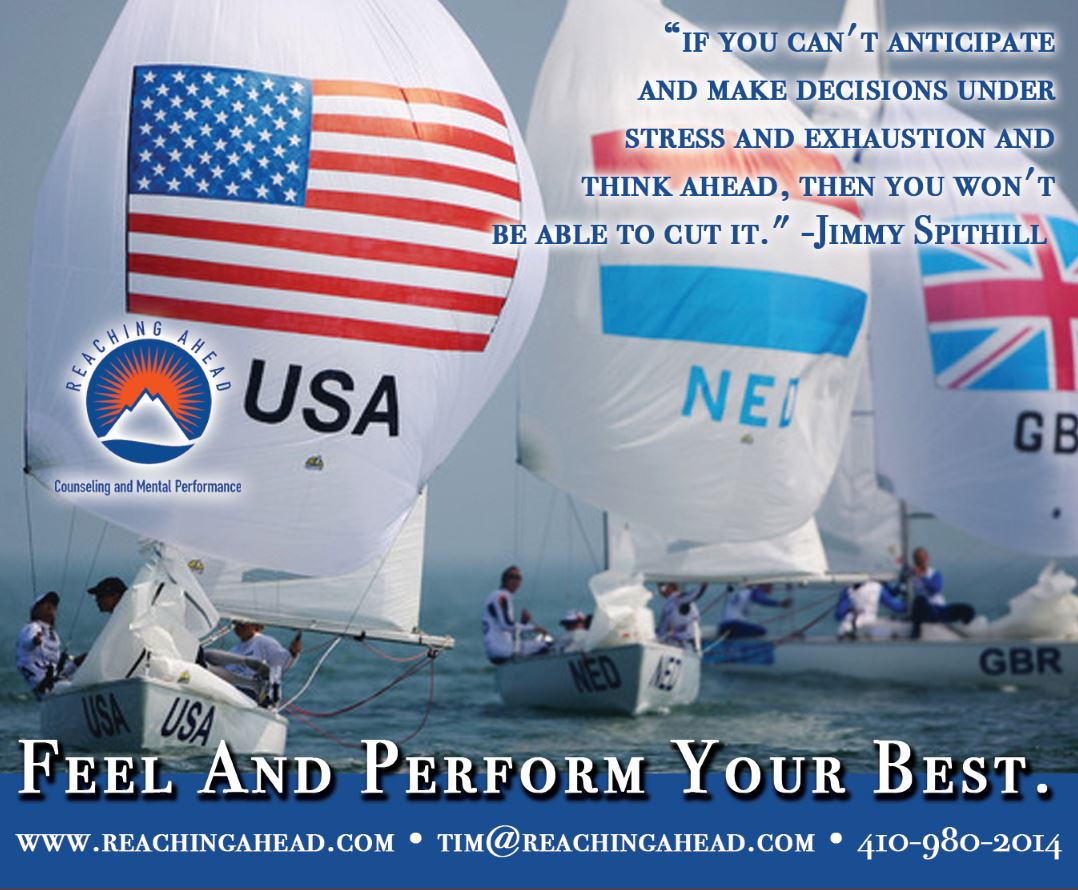
An athlete’s energy management is influenced by some of these same factors, plus lifestyle choices, and through psychophysiological techniques like developing an optimally paced breath. This makes a difference on and off the water, especially in the midst of stressful tactical situations. Energy management techniques can also contribute to more flexible attention. Demonstrating that we usually can’t “control” attention, I often tell sailors “don’t think about pink elephants.” Close your eyes for 10 seconds and try it. Your brain is likely already filled with pink elephants. We might not be able to control attention, but we can be mindful about steering it directions that are more helpful, creating attention habits through good routines. Mental (movement-focused) imagery can be a useful to sailors and other athletes across situations such as: preparing for certain regatta sites, honing a boat handling skill, spontaneous usage on or off the race course, or by combining it with traditional coaching techniques such as video analysis.
With coaches and others, I often work on good communication skills. Contrary to popular belief, it is not a pre-requisite for teams to get along socially. “Task cohesion” is much more important than “social cohesion.” Sailors need to know that they can count on important people like their coaches or their crew. And when everything else (including trust) is in place, good social relationships can add a synergy to the package. It makes the experience fun and can fuel motivation. Whether communicating task needs or social needs, learning a balance between a directive and collaborative style can make all the difference and making sure that the other person feels heard. Cliché, but true, we have two ears and one mouth for a reason!
Formats for the work I do with sailors and athletes can vary. Ideal training can involve ongoing individual consultation for coaches and/or sailors, and can incorporate in-person meetings for teams. Check out my new mental training programs for junior sailors, adults, and coaches!
___________________
Dr. Tim Herzog’s practice, Reaching Ahead Counseling and Mental Performance, is located in Annapolis, Maryland. An avid sailor himself, Tim moved back east 4 years ago from Bozeman, Montana, in order to be on the water and involved with sailing again. Tim combines a background of academic rigor (2 Masters and a Doctorate) with practical sailing (4th at J70 Mindwinters, 2016) and coaching experience (former Head Coach at Boston College, 5th at Dinghy Nationals + 4 All-American Honors). He enjoys working with sailors on the mental game, and helping athletes to surpass whatever barriers to performance.
Calling all Cars, One-Design ABP: Missing i420 Trophy. Can You Help?
From Yale Sailing Coach Bill Healy:
I’m trying to find the original US I420 perpetual national championship trophy. I have a not so great photo of it attached here. It’s 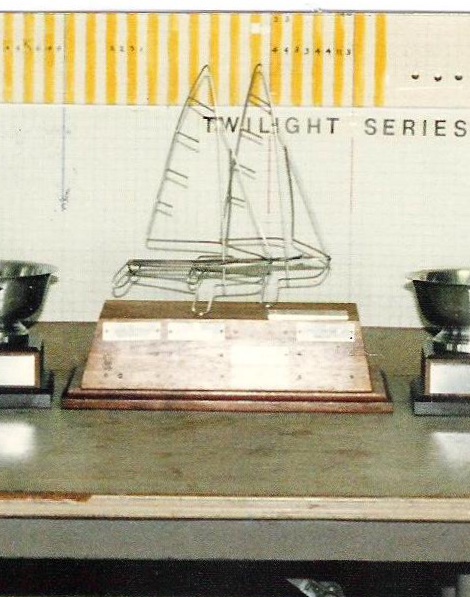
If you have any information leading to the discovery of this trophy, please EMAIL US!



